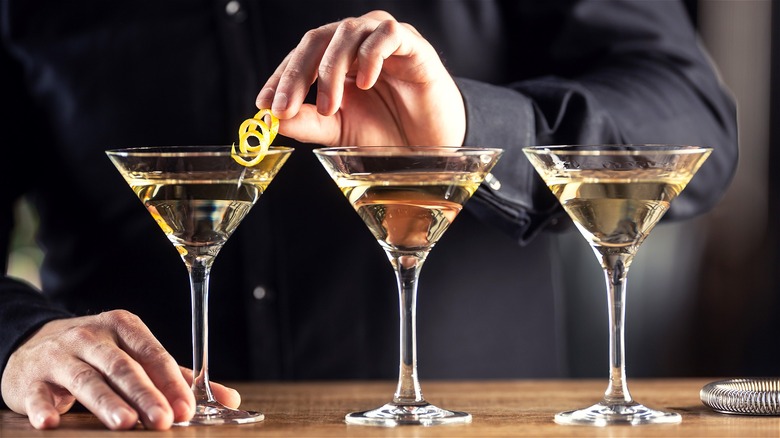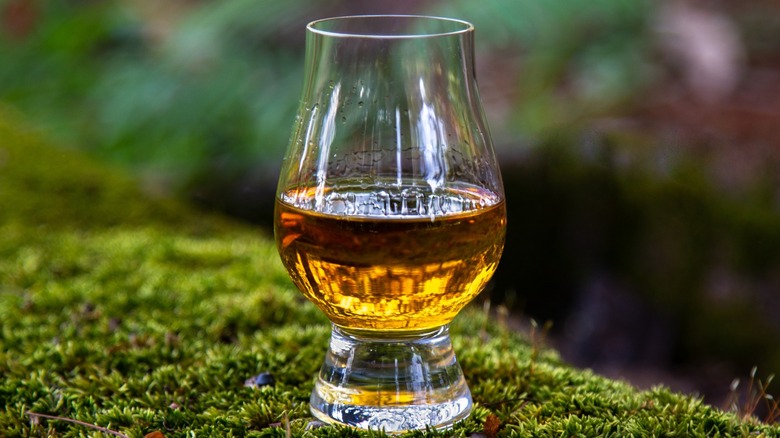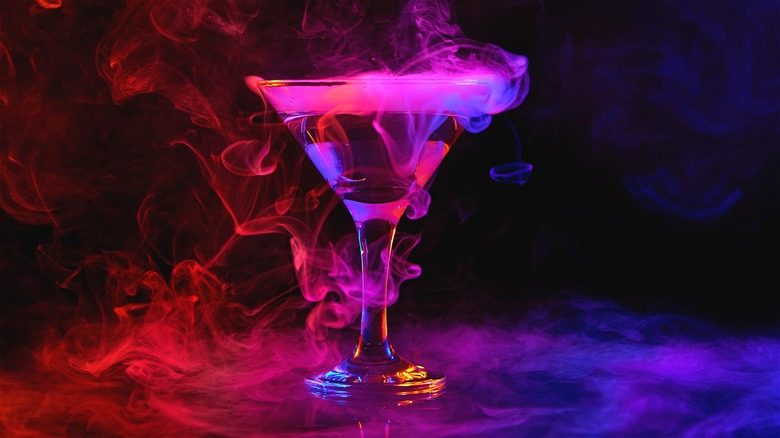What Does It Mean To Drink A Burnt Martini?
If you see a burnt martini on a cocktail list at a bar, you might expect the drink to be served flaming — or at least smoking. But the reality is not quite so theatrical. Rather, a burnt martini simply means adding a touch of smoky Scotch whisky to a classic dry gin martini recipe. While it's not one of the more common martini variations, it adds a savory depth of flavor and warm color to the classic cocktail.
A regular dry martini tends to be mixed using five parts gin (or vodka) to one part vermouth, but adjusting the ratio gives very different results in terms of taste. Taking your martini "dry" or "extra dry" means reducing the quantity of vermouth, ordering a martini "naked" involves lowering it even further, and making it "wet" means increasing it. Because a burnt martini incorporates an additional spirit, the ratios are different again, and very much depend on personal preference.
In fact, a burnt martini can be made either with or without vermouth. If you're making it with vermouth, start with four parts gin, one part dry vermouth, and one part Scotch, then adjust to taste. If you prefer it without vermouth, try a bolder ratio of two parts gin to one part whisky. Either way, be sure to stir or shake the mixture with ice so it's perfectly chilled, as nobody wants the kind of burn you get from drinking a glass of room-temperature mixed spirits.
Use a peaty single malt for a smoky burnt martini
To achieve the signature smoky flavor in a burnt martini, it's important to use the right ingredients. The drink usually contains Scotch whisky rather than whiskey, since you're looking for spicy and savory flavors to go with the aromatic gin, rather than the sweet vanilla and caramel notes you might get in something like bourbon. A single malt is ideal, and, to really ramp up the smoky notes, it's worth looking at the more peaty varieties.
The Scottish island of Islay is where you'll find the peatiest Scotch whiskies, with famous brands including Laphroaig, Lagavulin, and Ardbeg. These spirits get their intense flavor from the peat fires used to dry the barley, and they can vary in terms of how strongly the smokiness comes through. The taste can range from earthy or leathery to bonfire-like, and this flavorful characteristic makes it easy to see why the martini is described as burnt.
For the other ingredients, you'll want a London dry gin, and dry vermouth (rather than a sweet one) to keep the flavors sharp. Adding a single dash of orange bitters will deliver a burst of fragrance and balance to what is a very savory and strong drink. You can enhance this further by garnishing the cocktail with a citrus peel such as from an orange, lemon, or grapefruit.
More ways to add a smoky flavor to a martini
If you fancy a smoky taste in your martini but aren't such a fan of Scotch whisky, then there are other ways to infuse the drink with similarly rich and savory notes. Try switching single malt for a little mezcal, which often has an equally smoky profile. The mezcal also helps to really bring out the herbal flavors of the vermouth. Go for two ounces of dry gin, half an ounce of dry vermouth, and just a teaspoon of mezcal for a single serving.
Another way to incorporate smoky flavors is through the garnish. Try flaming a strip of citrus peel using a match to give it a more intense aroma and taste. You could also use smoking pine needles or hard herbs to switch up the fragrant flavors. Or, for extra savoriness, adding a garnish of cocktail onions — rather than a citrus peel — will transform a martini into a Gibson cocktail, and add extra umami-rich punchiness to the drink.
Of course, the most straightforward way to add smoke to a standard dry martini is to actually smoke it using a smoking gun or kit. Using oak or hickory wood chips will deliver delicious campfire-like flavors, while also bringing a bit of drama to the presentation. Strain it before serving it chilled to achieve a smooth consistency with a subtle yet beautiful burn.



